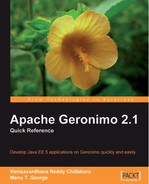Chapter 13. Logging
The ability to log important events or errors for problem diagnosis and then checking of application execution is very important. The ability to log certain statements selectively while others are not logged, depending on the context in which the application is running, is also important. An application that is deployed in Apache Geronimo can use any custom logging mechanism to log its messages. However, Apache Geronimo uses log4j and slf4j for logging server log messages. Applications deployed in Geronimo can also leverage the functionality of these logging frameworks. In this chapter, we will see how an application developer can configure logging for his application in Apache Geronimo, by using some common logging frameworks. The frameworks that we will be covering are:
Apache log4j
Java logging API
slf4j logging adapter
We will start by briefly looking at each of the logging frameworks mentioned above, and will then go into how the server logs events and errors and where it logs them to. After examining them, we will look into the different ways in which we can configure application logging.
Apache log4j: Log4j is an open source logging framework that is developed by the Apache Software Foundation. It provides a set of loggers, appenders, and layouts, to control which messages should be logged at runtime, where they should be logged to, and in what format they should be logged. The loggers are organized in a tree hierarchy, starting with the root logger at the top of the hierarchy. All loggers except the root logger are named entities and can be retrieved by their names. The root logger can be accessed by using the Logger.getRootLogger() API, while all other loggers can be accessed by using the Logger.getLogger() API. The names of the loggers follow the rule that the name of the parent logger followed by a '.' is a prefix to the child logger's name. For example, if com.logger.test is the name of a logger, then its direct ancestor is com.logger, and the prior ancestor is com.
Each of the loggers may be assigned levels. The set of possible levels in an ascending order are—TRACE, DEBUG, INFO, WARN, ERROR, and FATAL. If a logger is not assigned a level, then it inherits its level from its closest ancestor. A log statement makes a logging request to the log4j subsystem. This request is enabled only if its logging level is higher than or equal to its logger's level. If it is lower than the log, then the message is not output through the configured appenders.
Log4j allows logs to be output to multiple destinations. This is done via different appenders. Currently there are appenders for the console, files, GUI components, JMS destinations, NT, and Unix system event loggers and remote sockets. Log4j is one of the most widely-used logging frameworks for Java applications, especially ones running on application servers. It also provides more features than the other logging framework that we are about to see, that is, the Java Logging API.
Java Logging API: The Java Logging API, also called JUL, from the java.util.logging package name of the framework, is another logging framework that is distributed with J2SE from version 1.4 onwards. It also provides a hierarchy of loggers such as log4j, and the inheritance of properties by child loggers from parents just like log4j. It provides handlers for handling output, and formatters for configuring the way that the output is displayed. It provides a subset of the functionality that log4j provides, but the advantage is that it is bundled with the JRE, and so does not require the application to include third-party JARS as log4j does.
SLF4J: The Simple Logging Facade for Java or SLF4J is an abstraction or facade over various logging systems. It allows a developer to plug in the desired logging framework at deployment time. It also supports the bridging of legacy API calls through the slf4j API, and to the underlying logging implementation. Versions of Apache Geronimo prior to 2.0 used Apache Commons logging as the facade or wrapper. However, commons logging uses runtime binding and a dynamic discovery mechanism, which came to be the source of quite a few bugs. Hence, Apache Geronimo migrated to slf4j, which allows the developer to plug in the logging framework during deployment, thereby eliminating the need for runtime binding.
